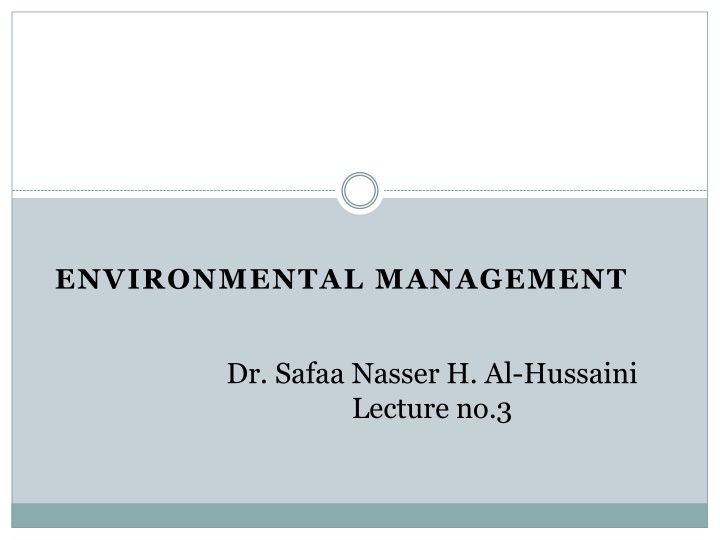
Environmental Management Approaches and Regulations Overview
Explore the standards, indicators, management approaches, requirements, and regulations in environmental management. Learn about different schemes, programs, and central questions guiding environmental policies globally.
Download Presentation

Please find below an Image/Link to download the presentation.
The content on the website is provided AS IS for your information and personal use only. It may not be sold, licensed, or shared on other websites without obtaining consent from the author. If you encounter any issues during the download, it is possible that the publisher has removed the file from their server.
You are allowed to download the files provided on this website for personal or commercial use, subject to the condition that they are used lawfully. All files are the property of their respective owners.
The content on the website is provided AS IS for your information and personal use only. It may not be sold, licensed, or shared on other websites without obtaining consent from the author.
E N D
Presentation Transcript
ENVIRONMENTAL MANAGEMENT Dr. Safaa Nasser H. Al-Hussaini Lecture no.3
Standards and Indicators: Standards: are specified values or conditions established to allow comparison with. Indicators: are measured or calculated values used to evaluate a particular subject throughout comparing the results with their standard values.
Environmental Management Approaches: 1. (Remedial Approach) Environmental Pollutions treatment and Control Approach. (Stockholm Index 1972) 2. (Political Approach) Environmental Resources Protection Approach. (Our Common Future 1987) 3. (Precautionary Approach) Environmental-Development Planning Approach. (Earth Summit 1992, 2002, 2012) 4. (Green Politics) Deep Ecology Approach. (Environmental mystics)
Environmental Management Requirements: 1. Environmental database and information. 2. Determination of the objectives and the policy should be made due to these objectives. 3. Programs for implement the policy. 4. Monitoring implemented program. and evaluation of the 5. Public and experts participations.
Environmental Regulations These extensively in many countries: regulatory approaches have been applied First: (Traditional Approach) command and control scheme, Second: pollution discharge fees scheme Third: tradable pollution permits scheme, The second and third schemes are regarded (Incentive-based Approach)
command and control scheme The different types of programs based on command and control are: Ambient standards. Effluent and emission standard. Technology-based effluent and emission standards. Performance standards. Technology-forcing standards. Technology standards. Management practice standards. Product bans. Information generation and disclosure requirements.
The question, that is central to the design of many commands and control programs, is what levels of waste reduction should pollutants be required to undertake?
pollution discharge fees scheme discharge fees can replace discharge standards
Costs and benefits of pollution abatement by a hypothetical firm
tradable pollution permits scheme creating legal rights to pollute and allowing the rights to be bought and sold like ordinary commodities
Implementing Environmental Regulations To regulations, two steps are to be done: insure implementing the environmental 1. Monitoring Performance Enforcing Regulations 2.
Monitoring Performance 1. Continuing Compliance 2. Self-Monitoring 3. Monitoring Visits 4. Self-Certification
Enforcement Responses taken by Environmental Agencies Informal Response formal Response
Informal Response Techniques: 1. Letters 2. Phone calls 3. Meetings 4. Notices of Violation
Informal Response Goals: 1. Notify requirements are being violated. polluters that environmental 2. Inform polluters of actions polluters must take to comply with requirements.
Formal Response Techniques: 1. Administrative proceedings 2. Civil actions 3. Criminal actions
Formal Response Goals: Use agency's ability to impose sanctions to force polluters to comply with requirements.















